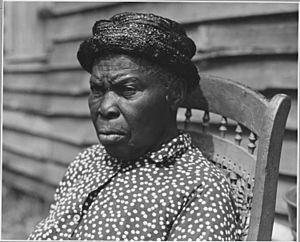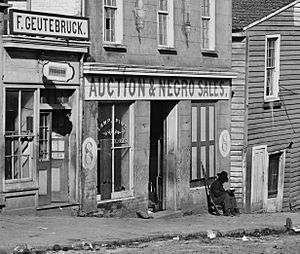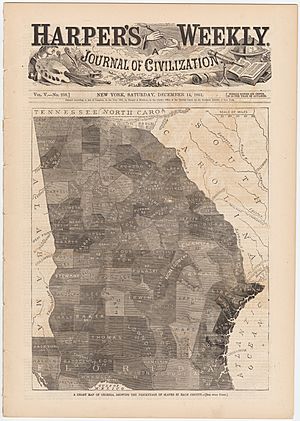History of slavery in Georgia facts for kids

Slavery in Georgia refers to the time when people were forced to work without pay in the U.S. state of Georgia. European colonists brought this practice to the area. Over time, it grew into a huge system of large farms called plantations, where many enslaved people were forced to work.
When the Province of Georgia was first set up in 1735, its leader, James Oglethorpe, actually banned slavery. Georgia was the only one of the Thirteen Colonies to do this. But by 1751, the ban was lifted by the king's order. This happened partly because a religious leader named George Whitefield supported slavery.
Contents
Early History of Slavery
Before Europeans arrived, Native American tribes sometimes took captives during wars. These captives might become part of the tribe, especially if they were children. This was different from European slavery, which focused on making money and was based on the idea that some races were inferior.
The first enslaved Africans in Georgia arrived in 1526. They came with a Spanish explorer named Lucas Vázquez de Ayllón. He tried to start a colony called San Miguel de Gualdape on the Georgia coast. But the enslaved people rebelled and joined with local Native Americans. This led to the colony's failure in less than two months.
Two hundred years later, Georgia was the last of the Thirteen Colonies to be founded, in the 1730s. At first, Georgia's leaders wanted to use workers from Britain, not enslaved people. They were also worried about attacks from Spanish Florida, where Spain offered freedom to enslaved people who escaped.
After Georgia colonists won a battle against the Spanish in the 1740s, more people wanted to allow slavery. They needed many workers for rice farms. So, in 1751, Georgia's leaders finally allowed slavery. After Georgia became a royal colony, ships began bringing enslaved people directly from Africa in the 1760s.
Cotton and Slavery (1793)

Georgia played a big part in the history of American slavery because of an important invention. In 1793, Eli Whitney invented the cotton gin. This machine quickly separated cotton fibers from their seeds.
The first demonstration of the cotton gin happened near Savannah, Georgia, on a plantation owned by a hero of the American Revolutionary War, General Nathanael Greene. The cotton gin made it much easier and faster to process cotton. This led to a huge increase in cotton farming.
Because cotton became so profitable, the demand for enslaved labor grew rapidly. The U.S. economy soon depended on cotton production. Cotton was sold to factories in the North and in England to make textiles.
Civil War and Freedom (1850–1865)
Georgia decided to leave the United States and join the Confederate States of America on January 19, 1861. This was a major step towards the American Civil War.
Years later, in 1865, during his famous "Sherman's March to the Sea," Union General William Tecumseh Sherman issued a special order. This order, called Sherman's Special Field Orders, No. 15, gave about 400,000 acres of land along the Atlantic coast to formerly enslaved people. Many of these people and their families are known today as the Gullah.
Slavery was officially ended in the United States by the Thirteenth Amendment to the Constitution. This amendment became law on December 18, 1865. Before this, President Abraham Lincoln had issued the Emancipation Proclamation in 1863. This proclamation declared that enslaved people in the states that were fighting against the U.S. government were free. However, many enslaved people did not gain their freedom until the Union Army took control of those areas.
Modern Efforts Against Forced Labor
In recent times, there have been cases of forced labor, which is sometimes called "modern-day slavery." In 2021, the U.S. Attorney’s Office in Georgia announced that 24 people were charged with various crimes. These included forcing people to work, handling illegal money, and mail fraud.
Prosecutors said that more than 100 people were forced to work under threats. Their passports and other important papers were taken away. They were held in crowded living spaces, including dirty trailers, and sometimes in work camps with electric fences.
Remembering the Past
People in Georgia have created memorials to remember the history of slavery.
In 2002, the city of Savannah put up a bronze statue on River Street. This statue honors the Africans who were brought to America as enslaved people through Savannah's port. River Street was a busy place where cotton and rice, grown by enslaved people, were loaded onto ships. Enslaved African Americans also laid the cobblestones that make up River Street.
In 2005, Wachovia Bank apologized to Georgia's African-American community. This was because one of its older companies, the Georgia Railroad and Banking Company, had used at least 182 enslaved people to build the Georgia Railroad.
See also
- Indian slave trade in the American Southeast
- African Americans in Georgia (U.S. state)
- List of plantations in Georgia (U.S. state)
- History of slavery in the United States by state


